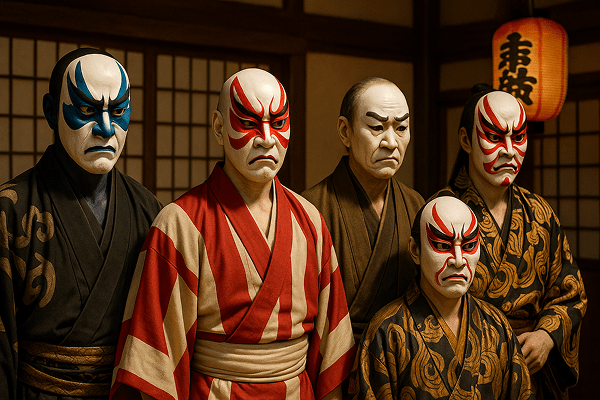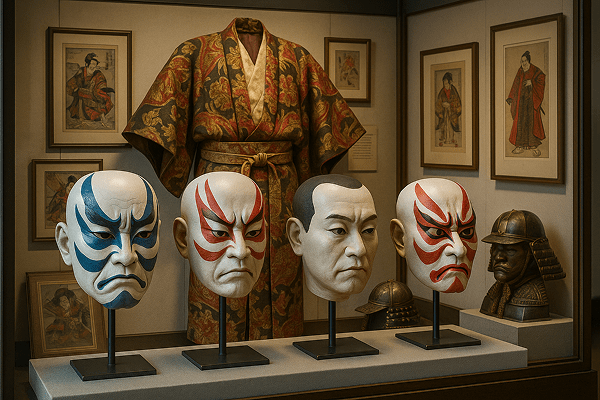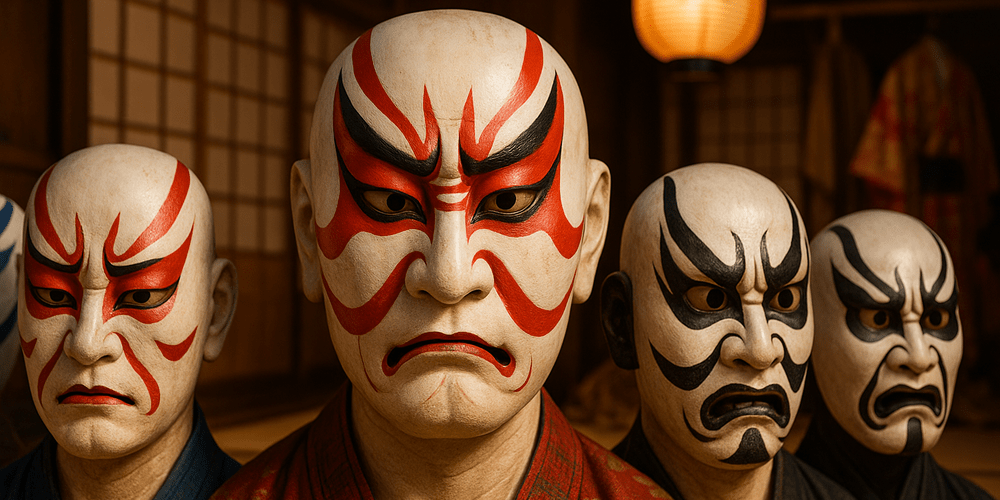Kabuki Theatre Masks are an iconic element of Japanese stage tradition, reflecting centuries of cultural evolution, artistic innovation, and dramatic storytelling. While full-face masks are less common in Kabuki than in Noh theatre, the term “Kabuki Theatre Masks” often refers to the elaborate painted faces and occasional mask-like props that define Kabuki’s visual style. These masks and make-up (kumadori) are renowned for their bold colors, exaggerated expressions, and dramatic designs, instantly recognizable to audiences both in Japan and worldwide. Kabuki Theatre Masks emerged during the early Edo period (17th century) and are closely associated with the vibrant culture of Tokyo (formerly Edo) and Osaka, two centers of Japanese theatrical life.
Historical Origins: The Evolution of Kabuki Masks
The origins of Kabuki Theatre Masks can be traced back to the dawn of Kabuki as a popular theatrical form in the early 1600s. The term “Kabuki” itself is derived from the verb “kabuku,” meaning “to lean” or “to be out of the ordinary,” reflecting the genre’s emphasis on spectacle, innovation, and stylized performance. In its early years, Kabuki incorporated elements from older art forms, including Noh and Kyogen, both of which featured traditional masks. However, Kabuki quickly developed its own visual language, relying more on painted faces than on physical masks, though certain roles — particularly supernatural or non-human characters — still used mask-like props. Over time, Kabuki Masks evolved in design, function, and symbolism, mirroring shifts in theatrical taste, audience expectations, and artistic trends. Historical artifacts, woodblock prints, and preserved costumes provide valuable insight into the transformation of Kabuki’s visual style. Notably, some Kabuki productions also reference or reinterpret the famous Hannya Masks from Noh theatre, enriching the intertextual dialogue between Japan’s performing arts.
Cultural Significance and Symbolism: Meaning of Kabuki Theatre Masks
Kabuki Theatre Masks and make-up serve not only as artistic devices but also as powerful symbols within Japanese culture. Each mask or face paint design conveys information about a character’s personality, moral alignment, and emotional state. For example, red lines symbolize strength and virtue, blue or indigo lines indicate villainy or supernatural power, and brown or black lines can denote age or humility. The visual codes of Kabuki masks are instantly understood by audiences and are integral to the storytelling process. Spiritually, Kabuki Masks are linked to Shinto and Buddhist beliefs, as performances often invoke protective spirits or legendary heroes. Socially, the masks and make-up help to break down boundaries between performer and audience, inviting collective participation in the dramatic experience. Kabuki’s use of visual symbolism has inspired countless myths and legends, further embedding the art form in Japan’s cultural consciousness.

Materials and Craftsmanship: Creating Kabuki Theatre Masks
Traditional Kabuki Masks, when used, are typically crafted from lightweight wood, lacquer, papier-mâché, or even leather. The process begins with designing the character’s features, followed by carving, molding, or layering materials to achieve the desired form. Artisans use fine chisels, brushes, and specialized paints to create intricate designs and vibrant colors. However, more often than not, actors employ kumadori make-up, which is applied directly to the face using brushes and pigments made from natural minerals and plant dyes. The color palette is highly symbolic, with each hue carefully chosen for its narrative function. Decorative elements, such as attached hair, fabric, or gold leaf, further enhance the mask’s dramatic effect. Regional differences in craftsmanship and style exist, with Tokyo and Osaka schools favoring distinct approaches to design and application.
Functions and Use: Kabuki Masks in Ritual, Theatre, and Festivals
Kabuki Theatre Masks and make-up are primarily used in theatrical performances, where they transform actors into gods, demons, warriors, and courtesans. In some traditional rituals and temple festivals, mask-like props may also be used to evoke protective spirits or legendary figures. Throughout the Edo period, Kabuki performances became central to urban cultural life, drawing huge crowds and influencing fashion, visual art, and language. Over time, the use of masks and make-up has adapted to changing theatrical conventions, with contemporary Kabuki productions sometimes experimenting with new materials, digital projections, or hybrid forms. Today, Kabuki Masks and kumadori make-up remain essential to the art form’s identity, captivating audiences in Japan and around the world.
Regional Variations: Styles of Kabuki Theatre Masks Across Japan
While Kabuki is most closely associated with Tokyo and Osaka, regional variations in mask and make-up styles can be observed throughout Japan. Different troupes or schools may emphasize particular color schemes, facial designs, or decorative motifs. For example, the Edo style is known for its bold, graphic lines, while the Kamigata (Osaka-Kyoto) style often features more subtle, nuanced expression. Unique local traditions may also incorporate elements from Noh, Kyogen, or folk festivals, resulting in a rich tapestry of visual diversity. When compared to other mask traditions, such as those found in Noh or Bugaku, Kabuki Masks stand out for their theatricality, use of make-up, and emphasis on dramatic storytelling.
Famous Examples and Collections: Where to See Kabuki Masks
Notable Kabuki Masks and make-up artifacts are preserved in major museums such as the National Theatre of Japan, the Edo-Tokyo Museum, and the Osaka Museum of History. These institutions display historical masks, costumes, and stage props, offering a window into the evolution of Kabuki’s visual culture. Private collections and theatrical archives also contain rare examples, some of which are occasionally exhibited to the public. For those interested in viewing or acquiring authentic Kabuki Masks, online platforms like toddmasks.com offer curated selections and educational resources.

Influence on Art and Culture: Kabuki Masks in Modern Creativity
Kabuki Theatre Masks and make-up have had a profound influence on Japanese and global art, inspiring painters, sculptors, filmmakers, and fashion designers. The bold lines and dramatic expressions of Kabuki have appeared in everything from ukiyo-e woodblock prints to contemporary anime and film. In literature and music, Kabuki’s visual motifs are used to evoke themes of transformation, power, and identity. Modern fashion houses have also drawn inspiration from Kabuki Masks, incorporating their stylized forms into clothing, accessories, and stage costumes. The enduring popularity of Kabuki’s visual style plays a crucial role in preserving Japanese cultural heritage and promoting creative innovation. The cross-pollination with other mask forms, such as the Hannya Masks, highlights the interconnectedness of Japan’s theatrical traditions.
Modern Status and Preservation: Keeping the Kabuki Mask Tradition Alive
Today, the tradition of Kabuki mask-making and make-up application is upheld by master craftsmen, actors, and cultural organizations. Training programs, apprenticeships, and educational workshops ensure that traditional techniques are passed down to new generations. Modern adaptations include the use of synthetic materials, digital design, and multimedia integration, but the core principles of craftsmanship and symbolism remain unchanged. Museums, festivals, and academic institutions play a key role in documenting, exhibiting, and teaching about Kabuki Masks, ensuring their continued relevance in the 21st century.
Collecting and Acquisition: The Market for Kabuki Theatre Masks
The market for Kabuki Theatre Masks includes both antique and contemporary examples. Authentic masks can be purchased from specialized galleries, museum shops, and reputable online platforms like toddmasks.com. Prices vary depending on age, rarity, craftsmanship, and provenance. When collecting, it is important to seek documentation of authenticity, support ethical sourcing, and appreciate the cultural context of each mask. Collectors should be aware that some masks are intended for theatrical use, while others are created as decorative or commemorative items.
